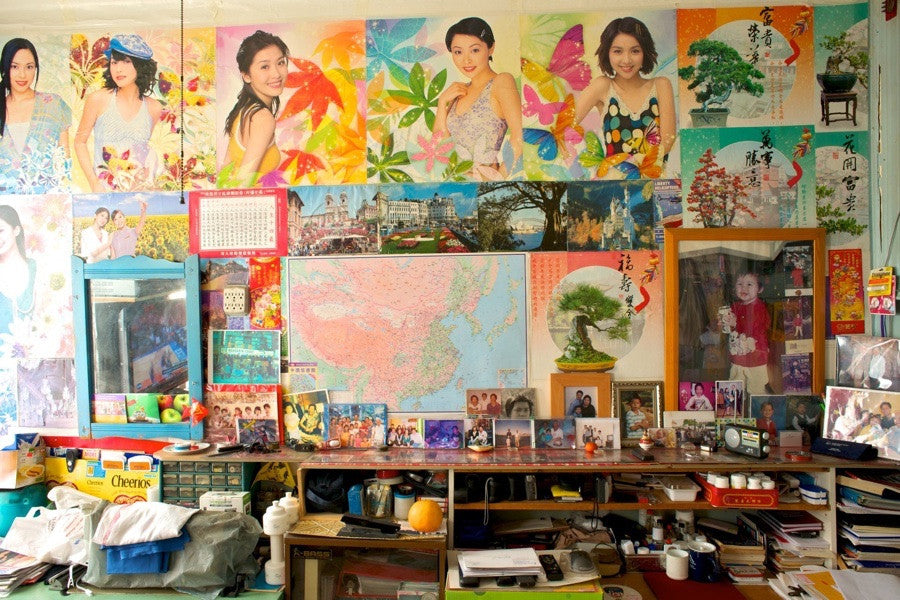
Louis Chan, Artist-in-Residence, Explores Home and Belonging
Disney decals. Stuffed pink pigs. A map of China. These are just some of the ways Chinatown residents decorate their apartments in My Home, Louis Chan’s photo series.
The larger-than-life pictures from our latest artist-in-residence explore New York City immigrants’ lives in America through their possessions and how they display them. We had the chance to speak with the Lower East Side native about the inspiration behind his photographs, how he decided to become an artist, and the many layers of his work.
How did you come up with the idea for the series?
I was born in New York City and grew up in a typical immigrant family. My mom’s from Hong Kong and my dad from Taishan on the mainland. My mom was a seamstress and my dad worked in a restaurant. Of course they wanted me to pursue a more economical career. Business, engineering. But I decided to go for an art degree.
When it came time to do my thesis, I thought about doing something more contemporary and academic. But I was always interested in sociology, and decided to do something that excites me and was important to me.
It turned out to be very difficult getting into strangers’ home. So I started with friends and family. As I was photographing, I had an aha moment. I noticed a level of comfort and items in the house that all had a familiar theme. Products, decor, lack of decor.
Like what specifically?
Chinese calendars, Ovaltine, rice cookers, drawings. The kind of crappy paint jobs you see in walk-up tenements. Bunk beds. The same commonality. I realized I should focus more on that, and how two worlds were going on between immigrant parents and their American-born kids.
Immigrant families with kids always have this duality. Chinese have a tendency not to assimilate. It’s why Chinatowns exist — to serve their own communities. But for those of us born here, there’s a pressure to assimilate. To not talk with an accent.
People look at the photos and ask if they’re in China, and they’re surprised to learn they’re in NYC.
I thought the same thing. They look like homes I saw in China, and not like where I grew up in the suburbs.
The work has those different layers. It addresses the lack of space that comes with living in New York. And socioeconomic issues as well, like not having money to decorate.
My folks always saved everything. Plastic bags, containers, boxes. And I saw that too in other people’s homes. The lines start getting blurred. Is this person a hoarder? Or do they have no money? Or are they using whatever they can to design their space? Or is it because if you have no space, whatever you save looks like a lot? Or are they continuing to save everything like they did when they were extremely poor back in Hong Kong?
I’m trying to live a clutter-free life, but I do collect glass jars. I call it a collection, but something in me wants to save everything. My wife asks me why I have all these jars, and I say maybe we can start putting flowers in them. But we never do.
When did you become interested in photography?
Shortly after high school. My uncle had a film camera that I borrowed when I went on a trip. I had a lot of fun playing with images. A lot of it didn’t turn out well because I didn’t know what I was doing. Then digital came out. I always enjoyed it but never thought it could be a career. The hungry artist stigma compounded with a conservative Asian family resulted in: Don’t do the creative thing.
How did your parents feel when you decided to pursue photography?
I did well in high school, but right after I fell off. I went to college but did extremely poorly. I got academic probation. Had dead end jobs. One day I finally got my act together and enrolled in BMCC [Borough of Manhattan Community College]. I was much more gung ho. I planned to study business, become a responsible adult, and work for a bank or something. I did really well, but photography kept calling.
My parents lectured me so many times, they just ran out of energy. They were thinking: There’s no money in photography but at least he’s doing something.
What were the turning points in your life?
I had an inspiring talk with someone who’s now a colleague. He said, “Do you want to do business or take photographs?” I said I want to take photographs. He said you should do that. There’s money to be made if you’re good.
Another turning point was when I went back to BMCC. I worked at a hedge fund for 3 or 4 years. I went from filing and data entry to attending analysts’ meeting and sitting down with companies trying to raise money for projects. I wrote reports. I was making $30,000 and everyone was making three to four times as much. I realized then I needed my degree so I could earn that much too.
But this sociology class turned my world upside down. It woke me up to everything that’s happening in the world. How the working class always gets the short end of the stick. How the rich gets richer, and the poor gets poorer. I couldn’t be part of that industry. To me, that’s not really contributing to society.
What are you working on now?
I had the chance to go to Taishan about five years ago and to visit where my paternal grandmother grew up. I did some photographs there. I’ve thought of extending the My Home project, following the lineage back home. That’s the way I usually work. I feel like it’s never finished. It can always grow.
My Home is on display in our mezzanine gallery from March 18 through May 12. To see more of Chan's work, follow him on Instagram.
(Interview conducted by Angela Tung)
